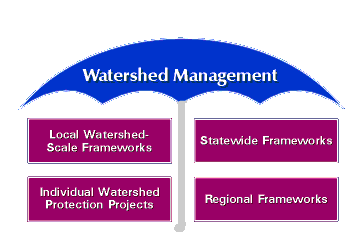Defining Watershed Management Framework
There is not a single blueprint for a watershed management framework. Frameworks are usually designed and built to meet specific conditions and needs. For example, the components of a local watershed framework designed to protect a municipal water supply might differ substantially from a statewide framework based on broader ecological restoration and protection goals.
Because watershed management needs are ongoing and ever-changing and therefore cannot be addressed by a one-time planning effort, those involved in or affected by management need an organized framework for coordinating efforts over time. Put simply, a watershed management framework is "a lasting process for partners working together." The process can include agreed upon activities to work on together, timelines, operating procedures, and ways to communicate with each other, such as computer links and shared forums. The agencies, organizations, and individuals that work together to build and implement frameworks are referred to as "partners." To ensure that the process moves from paper agreement to daily operation, most frameworks include a support structure of coordination forums that make it easier for partners to work together to meet shared management goals.
This tutorial focuses on one type of framework that is flexible to many needs - the Statewide Watershed Management Approach.
![[logo] US EPA](https://www.epa.gov/epafiles/images/logo_epaseal.gif)
